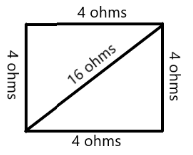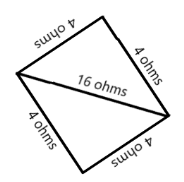
A uniform wire of $16\Omega $ resistance is made into the form of a square. Two opposite corners of the square are connected by a wire of resistance $16\Omega $. The effective resistance between the other two opposite corner is
(A) $32\Omega $
(B) $16\Omega $
(C) $8\Omega $
(D) $4\Omega $
Answer
560.7k+ views
Hint The configuration of the wires is similar to that of a Wheatstone bridge. The voltage between the two parallel resistors of a Wheatstone bridge is zero if it is balanced. So on removing the middle wire, we can then calculate the equivalent resistance.
In this solution we will be using the following formula;
$\Rightarrow \dfrac{1}{{{R_{eq}}}} = \dfrac{1}{{{R_1}}} + \dfrac{1}{{{R_2}}} + ... + \dfrac{1}{{{R_n}}}$ where ${R_{eq}}$ is the equivalent resistance of a resistors in parallel, ${R_1}....{R_n}$ are the individual resistors in the parallel configuration.
$\Rightarrow {R_{eqs}} = {R_1} + {R_2} + ... + {R_n}$where${R_{eqs}}$ is the equivalent resistance of resistors in series and ${R_1}....{R_n}$ are the individual resistances.
Complete step by step answer

The figure above shows the wire after it has been made into a square with the sixteen ohms resistor connected across the two corners of the square. This configuration resembles a Wheatstone bridge as shown in the figure below in a more familiar setting

To calculate the equivalent resistance, we assume a voltage is applied at any of the opposite corners of the square. This is allowed because all resistances are equal.
Let’s say we placed the voltage at the opposite corners to where the 16 Ohms resistor is connected. Since, it is a balanced Wheatstone bridge, the voltage across the 16 Ohms is zero. Hence, we can ignore the 16 Ohms resistance. The two resistance at the top are in series, likewise the two at the bottom. Hence,
For top resistance
$\Rightarrow {R_{eq1}} = {R_1} + {R_2} = 4 + 4 = 8\Omega $
For bottom resistance, similarly,
$\Rightarrow {R_{eq2}} = 4 + 4 = 8\Omega $,
This two resistance are in parallel, and hence calculated as
$\Rightarrow \dfrac{1}{{{R_{eq}}}} = \dfrac{1}{{{R_{eq1}}}} + \dfrac{1}{{{R_{eq2}}}} = \dfrac{1}{8} + \dfrac{1}{8}$
Computing we have that
$\Rightarrow \dfrac{1}{{{R_{eq}}}} = \dfrac{1}{4}$
$\Rightarrow {R_{eq}} = 4\Omega $
Hence, the correct option is D.
Note
To avoid confusions, we are allowed to assume a voltage across the opposite corners because from the definition of equivalent resistance of a circuit, it is the one resistance to the current flow in a circuit which can replace all the resistances in the circuit. Since the voltage across 16 Ohms is zero, no current flows through the resistor, and thus does not count to the equivalent resistance.
In this solution we will be using the following formula;
$\Rightarrow \dfrac{1}{{{R_{eq}}}} = \dfrac{1}{{{R_1}}} + \dfrac{1}{{{R_2}}} + ... + \dfrac{1}{{{R_n}}}$ where ${R_{eq}}$ is the equivalent resistance of a resistors in parallel, ${R_1}....{R_n}$ are the individual resistors in the parallel configuration.
$\Rightarrow {R_{eqs}} = {R_1} + {R_2} + ... + {R_n}$where${R_{eqs}}$ is the equivalent resistance of resistors in series and ${R_1}....{R_n}$ are the individual resistances.
Complete step by step answer

The figure above shows the wire after it has been made into a square with the sixteen ohms resistor connected across the two corners of the square. This configuration resembles a Wheatstone bridge as shown in the figure below in a more familiar setting

To calculate the equivalent resistance, we assume a voltage is applied at any of the opposite corners of the square. This is allowed because all resistances are equal.
Let’s say we placed the voltage at the opposite corners to where the 16 Ohms resistor is connected. Since, it is a balanced Wheatstone bridge, the voltage across the 16 Ohms is zero. Hence, we can ignore the 16 Ohms resistance. The two resistance at the top are in series, likewise the two at the bottom. Hence,
For top resistance
$\Rightarrow {R_{eq1}} = {R_1} + {R_2} = 4 + 4 = 8\Omega $
For bottom resistance, similarly,
$\Rightarrow {R_{eq2}} = 4 + 4 = 8\Omega $,
This two resistance are in parallel, and hence calculated as
$\Rightarrow \dfrac{1}{{{R_{eq}}}} = \dfrac{1}{{{R_{eq1}}}} + \dfrac{1}{{{R_{eq2}}}} = \dfrac{1}{8} + \dfrac{1}{8}$
Computing we have that
$\Rightarrow \dfrac{1}{{{R_{eq}}}} = \dfrac{1}{4}$
$\Rightarrow {R_{eq}} = 4\Omega $
Hence, the correct option is D.
Note
To avoid confusions, we are allowed to assume a voltage across the opposite corners because from the definition of equivalent resistance of a circuit, it is the one resistance to the current flow in a circuit which can replace all the resistances in the circuit. Since the voltage across 16 Ohms is zero, no current flows through the resistor, and thus does not count to the equivalent resistance.
Recently Updated Pages
Master Class 12 English: Engaging Questions & Answers for Success

Master Class 12 Economics: Engaging Questions & Answers for Success

Master Class 12 Social Science: Engaging Questions & Answers for Success

Master Class 12 Maths: Engaging Questions & Answers for Success

Master Class 12 Chemistry: Engaging Questions & Answers for Success

Master Class 12 Business Studies: Engaging Questions & Answers for Success

Trending doubts
What are the major means of transport Explain each class 12 social science CBSE

Which are the Top 10 Largest Countries of the World?

Draw a labelled sketch of the human eye class 12 physics CBSE

Explain sex determination in humans with line diag class 12 biology CBSE

The pH of the pancreatic juice is A 64 B 86 C 120 D class 12 biology CBSE

Explain sex determination in humans with the help of class 12 biology CBSE




